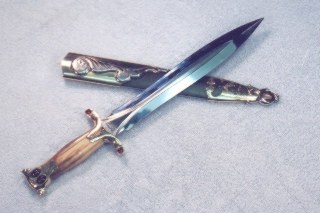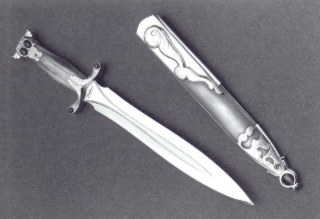The Witham Dagger
The whole [Celtic] race…is war-mad, and both high-spirited and quick for battle…. Strabo, first century BC.
By Joe D. Huddleston
Strabo’s Romans had good reason to fear the Celt’s aggressiveness, as they had been repeatedly beaten in battle by the tall, light-eyed barbarians from the north. The Celts believed in reincarnation and therefore had no fear of death. They thought the wearing of armor cowardly; and they fought naked, deliberately exposing themselves to the enemy’s weapons. To the Celts the brain was where both the mind and soul resided; so when they killed an enemy in battle they took his head as a trophy, in order to “possess” his intelligence and bravery. The warrior’s reason for existence was to gain personal glory on the battlefield. The Romans never defeated them in Scotland and Ireland.

Today when an American sees the word “Celtic” he is likely to think of a Boston basketball team called the “Seltics.” Actually the word for the race of people comes from the ancient Greeks, who called them Keltoi, and it is pronounced with a hard k: Kelts. They were a group of warrior tribes that spread across northern and western Europe and into the British Isles. Today the culture is strongest in Ireland, Wales and the Scottish highlands.
Even those who are familiar with the Celts usually think of them in relation to the currently popular jewelry made up of animals and interwoven knot work. Few realize that before the Celts adopted knot work from the Romans in the 400-600 time frame, they were well known for their abstract art based on plant forms; leaves, vines and tendrils. I am particularly attracted to a style used in Britain several centuries before Christ, technically called La Tiene IV.
The dagger seen here was designed using artistic elements from a La Tiene sword and shield, both made around 200 BC, and recovered from the Witham River in Lincolnshire, England. As you might expect, a great deal of interpretation and adaptation had to take place.
First, the blade. Today we expect that weapons this ancient would have pattern-welded blades. They did, but not in the common sense. The Celtic smiths used a mixture of available iron and steel for their blade cores, then forge-welded steel cutting edges in place. The result was a blade that often was of high quality but had none of the deliberately arranged patterning and etching that became so important to the Anglo-Saxons and Vikings a thousand years later. Blades of the La Tiene era were rather straightforward, plain affairs. Since I wanted a distinctive blade that was purely Celtic in design, I had to reach further back in time.
The answer was to go back to the bronze age and steal some ideas from Celtic bronze blades. I adopted the “finger notches” and the reinforcing ridges and grooves from bronze Celtic sword blades dating from around 1000 BC, when these were quite common features. The “wasp-waist” or leaf-shaped blade was used throughout the Celtic period. This combination of design elements resulted in a very graceful blade, quite distinctive, and true to the spirit of the piece.
For the hilt, more innovation. The shape of the lower edge of the cross guard was dictated by the shape of the top of the sheath, which was used universally throughout the La Tiene period. However, the original guards, grips and pommels were made of some organic material and were almost always totally rotted away. Few guidelines left me the freedom to do what I wanted but also left me the challenge of what to do.
I turned to the Witham shield for inspiration. The leaf shapes, coiled spirals and bat-wing forms I used came from the shield, as did the face-like shape of the pommel itself. The guard and pommel were carved from bronze, and I took advantage of the Celts known love for garnets to mount eight garnets in the hilt. The grip was formed of fossilized walrus ivory.
Design of the sheath was simpler. The throat of the sheath was almost a direct copy of the magnificent one on the Witham sword sheath, except that instead of forming the entire throat from a single piece of bronze by the repousse method (someday I’ll have to learn that technique) I made the domed and engraved portion from nickel silver, for a nice color contrast.

I used the most common Celtic construction for the body of the sheath which is bronze for the front and iron (in this case stainless steel) for the back. Again, for color contrast, I anodized the sheath front a medium bronze color and left the throat and chape polished bright.
I went back to the Witham shield for the designs used in the engraving on the sheet bronze portion of the chape (sheath tip) and used nickel silver for the three-dimensional tip, repeating the color pattern used on the throat.
So I hope if my Celtic British ancestors were right, and they have been reincarnated, that this blade suits their savage warrior souls.
Copyright (C) 1999 Oregon Knife Collectors Association. No part of this article may be reproduced without permission of the OKCA.
